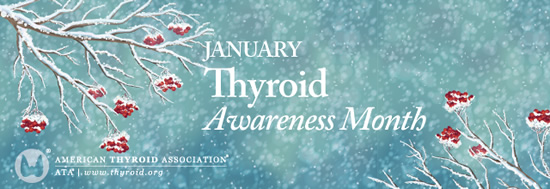Clinical Thyroidology for the Public summarizes selected research studies discussed in the previous month’s issue of Clinical Thyroidology, an official publication of the American Thyroid Association. Editor-in-chief, Alan Farwell, MD, FACE
Volume 12 Issue 1
Available in pdf format for saving and printing and Web page format for viewing online
PDF Format for Saving and Printing
Clinical Thyroidology for the Public Volume 12 Issue 1 (PDF file, 5.44 MB)
TABLE OF CONTENTS – Web Format
THYROID CANCER Too many thyroid ultrasound exams lead to an increase in the diagnosis of low-risk thyroid cancer
Increased medical imaging of any sort will lead to an increase in the diagnosis of small, potentially harmless thyroid nodules. More imaging may result in an increase in the diagnosis of low risk thyroid cancers that may not harm patients, whereas the treatment (surgery for example) may be more harmful than the disease. This study looks to see if more imaging leads to the diagnosis of more low risk thyroid cancers in patients over the age of 65.
Haymart MR et al 2018 Thyroid ultrasound and the increase in diagnosis of low-risk thyroid cancer. J Clin Endocrinol Metab. Epub 2018 Oct 16.
(PDF File for saving and printing, 653 KB)
THYROID CANCER Combining cancer staging systems and patient age improves survival predictions for thyroid cancer
Cancer staging systems are used to determine the extent to which a cancer has invaded and spread. Knowing the stage of one’s cancer provides information about prognosis (the lower the stage the better the prognosis) and potential treatments. The goal of the current study was to determine whether combining 2 updated classification systems would provide a more accurate estimate of survival for the Ghaznavi SA et al 2018 Using the American Thyroid Association risk-stratification system to refine and individualize the American Joint Committee on Cancer eighth edition disease-specific survival estimates in differentiated thyroid cancer. Thyroid. Epub 2018 Aug 2.
(PDF File for saving and printing, 666 KB)
THYROID CANCER Advanced thyroid cancer patients can have a prolonged response to lenvatinib
While most patients with thyroid cancer do very well with current therapy, 3-5% of thyroid cancer patients have progressive cancer after the initial treatment, therefore, requiring alternative therapies. On such drug is Lenvatinib, which showed that this medication stopped the cancer progression for a longer time as compared to no drug. The aim of this study was to evaluate the duration of response to lenvatinib.
Gianoukakis AG et al 2018 Prolonged duration of response in lenvatinib responders with thyroid cancer. Endocr Relat Cancer 6:699–704. PMID: 29752332
(PDF File for saving and printing, 624 KB)
HYPOTHYROIDISM Hypothyroidism during cancer therapy with tyrosine kinase inhibitors.
Hypothyroidism is often seen in patients being treated with TKI drugs for non-thyroidal cancers. Interestingly, the development of hypothyroidism during cancer treatment of non-thyroid cancer may be linked to improved survivals. This study examined the development of hypothyroidism in patients receiving TKI drugs for non-thyroid cancer and the effect on survival.
Lechner MG et al. 2018. Hypothyroidism during tyrosine kinase inhibitor therapy is associated with longer survival in patients with advanced nonthyroidal cancers. Thyroid 28:445–453. PMID: 29652597.
(PDF File for saving and printing, 624 KB)
THYROID FUNCTION TESTS A high proportion of serum rT3 tests are ordered by a relatively small number of providers in the United States
Reverse T3 (rT3) is not one of the primary hormones produced by thyroid gland. The production of T3 and rT3 is exactly opposite. Because of this relationship, and the fact that rT3 is inactive, most clinicians do not use measurement of rT3 for assessing thyroid function. Still, some providers continue to order rT3 in the assessment of thyroid function. This study was done to identify the ordering pattern of serum rT3 by clinicians.
Schmidt RL et al. Does reverse triiodothyronine testing have clinical utility? An analysis of practice variation based on order data from a national reference laboratory. Thyroid 2018 Jul; 28(7): 842-848.
(PDF File for saving and printing, 661 KB)
THYROID EYE DISEASE Adding mycophenolate to infusions of methylprednisolone improves treatment of Graves’ eye disease.
Severe Graves’ eye disease is usually associated with poor clinical outcomes and impaired quality of life. Treatment currently is intravenous methylprednisolone, but response is often limited and there are significant side effects to high dose steroids. This study aimed to compare the efficacy and safety of combination therapy of the immunosuppressive medication mycophenolate and methylprednisolone to the standard regimen of methylprednisolone alone.
Kahaly GJ et and the European Group on Graves’ Orbitopathy (EUGOGO). Mycophenolate plus methylprednisolone versus methylprednisolone alone in active, moderate-to-severe Graves’ orbitopathy (MINGO): a randomised, observer-masked, multicentre trial. Lancet Diabetes Endocrinol. 2018 Apr;6(4):287-298. doi: 10.1016/ S2213-8587(18)30020-2. Epub 2018 Jan 31.
(PDF File for saving and printing, 745 KB)





